Economic Analysis of Utilizing Compressed Natural Gas (CNG) as Vehicular Fuel in Nigeria
Anyadiegwu CIC*, Ohia NP and Muonagor CM
Department of Petroleum Engineering, Federal University of Technology Minna, Nigeria
Submission: March 27, 2017; Published: October 16, 2017
*Corresponding author: Anyadiegwu CIC, Department of Petroleum Engineering, Federal University of Technology Minna, Nigeria, Email: drcicanyafadiegwu@yahoo.com
How to cite this article: Anyadiegwu C, Ohia N, Muonagor CM. Economic Analysis of Utilizing Compressed Natural Gas (CNG) as Vehicular Fuel in Nigeria. Recent Adv Petrochem Sci. 2017; 3(4): 555618. DOI:10.19080/RAPSCI.2017.03.555618
Abstract
Economic analysis of the use of compressed natural gas (CNG) for powering automobiles was presented. The data for costs of constructing and running CNG-powered vehicles were obtained for the study. Economic analysis of running the CNG-powered vehicles was performed. The initial costs of project and operating costs amounted to N3.71 million and N1.31 million for CNG respectively. The net revenue for CNG is N2.55 million. Figures were used to determine the pay-out of the project which is 1.45 years. The Net Present Value (NPV) and other parameters that make up the project economics were estimated for CNG. The NPV for CNG at an expected rate of return of 10% is N15.7 million. The summary of the result of the calculations of all the parameters examined for CNG was also presented. From the whole analysis done it is easily seen that using CNG for powering vehicles is economically viable.
Keywords: Compressed natural gas; Economic analysis; NPV; Pay-out; IRR; Automobiles
Abbreviations: A: Annual Cost; BCF: Billion Cubic Foot; C: Total Capital Cost; CAPEX: Capital Expenditure; CC: Combustion Chamber; CCNG: CNG Cylinder; Ccoe: Chief Controller of Explosives; CNG: Compressed Natural Gas; COSCNG: Fuel Change Over Switch; CUM NCR: Cumulative Net Cash Recovery; EFG: Electric Fuel Gauge; EIA: Energy Information Administration; ER: Electronic Regulator; Fc: Fuel Cost; FP: Final Point; GJ: Gigajoule; I: Initial Cost of Vehicle; IP: Initial Point; IRR: Internal Rate of Return; Kg: Kilogram; KJ: Kilojoule; Km: Kilometer; L: Liter; Mc: Maintenance Cost; MCNG: Fuel Mixer; Mscf: Thousand Standard Cubic Foot; N: Naira; NCR: Net Cash Recovery; NM: Million Naira; NPV: Net Present Value; OEV: On-Off Electric Valve; OPEX: Operating Expenditure; PO: Pay-Out; Prds: Pressure Relief Devices; Pvs: Present Values; RE: Re-fuelling Electric Valve; REV: Revenue; SCF: Standard Cubic Foot; SVCNG: CNG Solenoid Valve; STB: Stock Tank Barrel; US DOE: United States Department of Energy; $: United States Dollar
Introduction
Natural gas is one of the cleanest, safest, and most useful forms of energy in our day-to-day lives. Natural gas is a hydrocarbon, which means it is made up of compounds of hydrogen and carbon. The simplest hydrocarbon is methane; it contains one carbon atom and four hydrogen atoms. Natural gas can be found by itself or in association with oil. It is both colorless and odorless. While mainly methane, the other hydrocarbons include ethane, propane, and butane. Water, oil, sulphur, carbon dioxide, nitrogen, and other impurities may be mixed with the gas when it comes out of the ground. These impurities are removed before the natural gas is delivered to our homes and businesses. The fact that natural gas is combustible and burns more cleanly than some other energy sources helps reinforce its position as one of the most highly used energy sources. Energy yielded by natural gas can be measured in a variety of ways, and the most common is the Gigajoule (GJ), which is one billion joules, the metric measure for heat or energy [1].
Compressed natural gas, or CNG, is natural gas under pressure which remains clear, odorless, and non-corrosive. Although vehicles can use natural gas as either a liquid or a gas, most vehicles use the gaseous form compressed to pressures above 3,100 pounds per square inch [2]. According to Wikimedia Foundation Inc [3]. Compressed natural gas (CNG) is a fossil fuel substitute for gasoline (petrol), Diesel fuel, and propane/ LPG. Although CNG's combustion does produce greenhouse gases, it is widely considered a more environmentally "clean” alternative to conventional fuels; plus, it is much safer than other fuels in the event of a spill (as natural gas is lighter than air, and disperses quickly when released). CNG may also be mixed with biogas (produced from landfills or wastewater).
CNG is used in traditional gasoline/internal combustion engine automobiles that have been converted into bi-fuel vehicles (gasoline/CNG). According to Mumtaz, [4] natural gas vehicles are increasingly used in Iran, the Asia-Pacific region (especially Pakistan and the Indian capital of Delhi, and other large cities like Ahmedabad, Mumbai, Kolkata, Chennai, etc), Latin America, Europe, and North America due to rising gasoline prices [5]. In response to high fuel prices and environmental concerns, CNG is starting to be used also in tuk-tuks and pickup trucks, transit and school buses, and trains. The need to pursue the development of alternative automobile fuel other than petrol and diesel in Nigeria is based on the following associated problems: the rising cost of refined products, such as petrol, diesel, etc; environmental pollution caused by petrol and diesel exhaust fumes; perennial scarcity of petrol and diesel due to poor state of Nigerian refineries.
Overtime there has been some level of scarcity of refinery fuels like gasoline and diesel in Nigeria. Although this does not occur at all times but it has led to the general increase in the cost of these fuels for drivers whose vehicles make use these refinery liquids as fuels. Thus the need for the invention of an alternative fuel like compressed natural gas (CNG) has sprung up. The main disadvantages of the use of CNG are that it has limited vehicle availability and it is less readily available than gasoline and diesel. The cost of conversion is also a barrier to wider/quicker adoption of CNG as a fuel. It is also why municipal government, public transportation vehicles were the most visible early adopters of it, as they can more quickly amortize the money invested in the new (and usually cheaper) fuel. In spite of these circumstances, the number of vehicles in the world using CNG has grown steadily (30% per year) [6].
Methodology
Converting petrol/diesel-powered vehicles to cng- powered vehicles
This conversion involves installing extra parts into the diesel-powered vehicles that would make them bi-fuel powered vehicles. This means that they would be able to be both powered by diesel and CNG. The flow chart for the extra components and their connection sequence for the conversion of diesel-powered vehicles to CNG-powered vehicles are shown in Figure 1 below:
A. Output of cng-powered vehicles
B. Heating Values
C. The heating value of CNG is 1518533 KJ/scf [7].
Evaluation of the economic viability of using cng- powered vehicles
The economic flow chart for running vehicles with CNG consists of the various costs at different stages: costs of putting the extra parts of the CNG-powered vehicle together, which are summed up to get the total capital cost as shown in Figure 2 below.
Costs Analysis
As in all infrastructural investments in the energy sector, manufacturing CNG-powered vehicles is capital intensive. Investors usually use the return on investment as an indicator for the viability of such projects. It has been estimated that investors require a rate of return of 12% to 15% for regulated projects, and close to 20% for unregulated projects. The higher expected return from unregulated projects is due to the higher perceived market risk. In addition significant expenses are accumulated during the planning and location of potential storage sites to determine its suitability, which further increases the risk [8].
The capital expenditure to manufacture the vehicle in Nigeria depends on the separate costs of the extra parts required to make the diesel-powered vehicles bi-fuel-powered vehicles. The conversion rate of naira to dollar as at April, 2014 is given as:
$1=N 161 2.1
Several items contribute to the total investment necessary to put CNG-powered vehicle into operation, as demonstrated in Figure 3 they include:
Cost of CNG cylinder
The CNG cylinder is meant for storing CNG in the vehicle for use. CNG cylinders are manufactured from a special steel alloy and are seamless in construction. Their compact size allows them to easily fit into a small car. An empty CNG cylinder with a 50 liter-water-carrying capacity weighs 48kg (approximately), and has a length of 835mm and a diameter of 316mm. The 50 liter capacity cylinder is the one most regularly used in CNG kits but cylinders with 45 liter, 55 liter, 60 liter and 65 liter capacity are used as well. A cylinder with a 50 liter water- carrying capacity is capable of carrying approximately 9kg of CNG. This is equivalent to 12.5 liters of petrol and will allow a run of about 150-160km for a medium sized 1300CC car. An electronic fuel gauge fitted on the dashboard which is part of the conversion kit indicates the quantity of CNG left in the cylinder. CNG cylinders are designed and built to withstand high pressure. The maximum pressure in a CNG cylinder is up to 200bar. CNG cylinders are safe as they are manufactured as per specific requirements and tested before use, in accordance with international specifications and standards, and are duly approved by the Chief Controller of Explosives (CCoE). Moreover, they are provided with a pressure relief device (PRD) that consists of a fusible plug and a burst disc that ruptures in case of extremely high pressure and temperature. On an average, vehicle owners lose about one third of their boot space when their car is converted to use CNG. The boot space also depends upon the size of vehicle and cylinder make. However people who wish to convert to CNG can still install carriers on their vehicles to compensate for the lost boot space [9].
Cost of electric fuel gauge
The electric fuel gauge is installed to check the level of CNG in the CNG cylinder and as such to show whether there is an enough fuel for an impending journey with the vehicle.
Cost of on-off electric valve
The electric on-off control valve is a hydraulically operated sleeve type valve with an electric solenoid control. The flow through the valve is controlled by a rubber sleeve which is actuated by hydraulic pressure. The valve is either in the fully opened or the closed (shut off) position when operated electrically. When the selector is pointed to the “AUTO” position then the electric solenoid is used to automatically open or close the valve. The 3-way electric solenoid must be energized to open the valve and de-energized to close the valve. Pointing the manual selector handle to “OPEN” or “CLOSE” will override the “AUTO” control. The manual selector can be used to hold the valve partly open by opening the valve part way and then pointing the selector handle midway between “OPEN” and “CLOSE” [10].
Cost of re-fuelling electric valve
This is a valve for dispensing natural gas. The valve itself functions as an internally piloted valve with a pilot orifice in the piston, which is one of the most important components of the valve. In order to withstand the high pressure, the piston is produced from a single piece of special plastic. Specially designed solenoid valves are required to control the flow of the CNG.
Cost of cng solenoid valve
A solenoid valve is an electromechanically operated valve. The valve is controlled by an electric current through a solenoid: in the case of a two-port valve the flow is switched on or off; in the case of a three-port valve, the outflow is switched between the two outlet ports. Multiple solenoid valves can be placed together on a manifold. Solenoid valves are the most frequently used control elements in fluidics. Their tasks are to shut off, release, dose, distribute or mix fluids. They are found in many application areas. Solenoids offer fast and safe switching, high reliability, long service life, good medium compatibility of the materials used, low control power and compact design. vi. Cost of Electronic Regulator: Electronic fuel pressure regulator works directly with line of CNG pumps to reduce heat build-up and vapor lock conditions related to the operation.
Cost of change over switch
Change over Switch is electronic control unit for interchange refinery fuel and gas of CNG injection cars. It is meant for switching from refinery fuel sucking to CNG sucking and vice versa.
Cost of mixer
This is a gas mixer for blending CNG and other additives required for its use in running vehicles. Conventional gas mixers have remained essentially unchanged for the past 40 years, based on proportional gas mix controlled manually and the need to increase the size of the mixer if a greater capacity is necessary. Furthermore, different gas mixtures often require different mixers to be used.
Cost of combustion chamber
This is the unit where the CNG fuel burns to yield the amount of energy expended in the course of running the vehicle.
Cost of other parts
This is the cost of putting other parts and the required body parts of the vehicle in place. This may also be referred to as the initial cost of the diesel-powered vehicle before it is converted to a bi-fuel-powered vehicle.
The total capital cost is given as the sum of the costs i to x.
Annual Operating cost = Fuel cost + Maintenance cost 2.2
Gross Revenue = Revenue per km moved *Km covered by the vehicle running on the available volume of CNG 2.3
Net revenue for subsequent years of operation
Gross revenue -Annual Operating cost 2.4
Result
1. The heating values and prices of CNG are as shown in Table 1 below:

2. Economic Analysis of CNG-Powered Vehicle
3. Costs Analyses for CNG-powered Vehicle
4. Total Capital Cost, (C)
5. Initial Cost of Vehicle, (I)
6. The cost of procuring a diesel-powered vehicle is $20000=N3.2 million
7. Cost of Installing the CNG Cylinder, (CCNG)
8. The cost of installing the CNG cylinder and its accessories is $280=N45080
9. Cost of Electric Fuel Gauge, (EFG)
10. The installation of electric fuel gauge is set at $59.38=N9560
11. Cost of On-off Electric Valve, (OEV)
12. The cost of buying and installing the on-off electric valve is $1000=N161000
13. Cost of the Re-fuelling Electric Valve, (RE)
14. The cost of installing the re-fuelling valve is $800=N128800
15. Cost of CNG Solenoid Valve, (SVCNG)
16. The installation of the CNG solenoid valve is set at $500=N80500
17. Cost of the Electronic Regulator, (ER)
18. The cost of buying and installing electronic regulator is $100=N16100
19. Cost of Installing Fuel Change Over Switch, (COSCNG)
20. The cost of installing the fuel change over switch is $200=N32200
21. Cost of Installing Fuel Mixer, (MCNG)
22. The installation of fuel mixer is set at $10=N1610
23. Cost of Installing Combustion Chamber, (CC)
24. The cost of installing the combustion chamber and Valve is $1000=N161000
25. Total Capital Cost (C)=I + CCNG + EFG + OEV + RE + SVCNG+ ER + COSCNG + MCNG + CC 3.1
26. Total Capital Cost (C)=$23049.38=N3.71 million
27. Annual Cost, (A)
28. Fuel Cost, (Fc)
According to Watt [11], the average kilometer per liter covered by a vehicle running on CNG is 1.66km/l. A vehicle that plies 93km to and fro within south-east, Nigeria would be covering a distance of 186km. If 1l of CNG can cover a distance of 1.66km then to cover a distance of 186km the volume of CNG that would be required is 112l. Since the cost of CNG is $0.38/l, Table 2: Cash flows for the CNG vehicle project over the space of 15 then the cost of 112l of CNG is $42.6. If the vehicle travels that 93km and back 15 times in a month it means that the cost of CNG for the 15 trips in a month is $638.7. Then the annual cost of fuel would be $638.7 * 12=$7664=N1.23 million
Maintenance cost, (mc)
The cost of maintaining the vehicle, servicing the engine and other parts and repairing the damaged parts would amount to about $40 per month which is $480 ie N77280 annually.
Annual Cost, A=Fc + Mc=$7664 + $480=$8144=N1.31 million
Revenue analyses for cng-powered vehicles
If the revenue the vehicle earns for one trip of 93km and back is $133, then Gross Revenue=$133*15* 12=$24000.
Annual Net Revenue=$24000 - $8144=$15856=N2.38 million
NPV and IRR for the CNG-powered Vehicle Project
Net Present Value, (NPV) is a measure of profitability of any project. The net present value of a time series of cash flows, both incoming and outgoing, is the sum of the present values (PVs) of the individual cash flows. NPV compares the value of 1 dollar today to its value in future, taking inflation and returns into consideration. If the NPV of a prospective project is positive, it is accepted. However, if NPV is negative, the project should be discouraged because cash flows will also be negative [12]. The cash flows in dollars for the CNG-powered vehicle project over the space of 15 years are shown in Table 1 and also the cash flows in millions of Naira for the CNG-powered vehicle project over the space of 15 years is shown in Table 2.
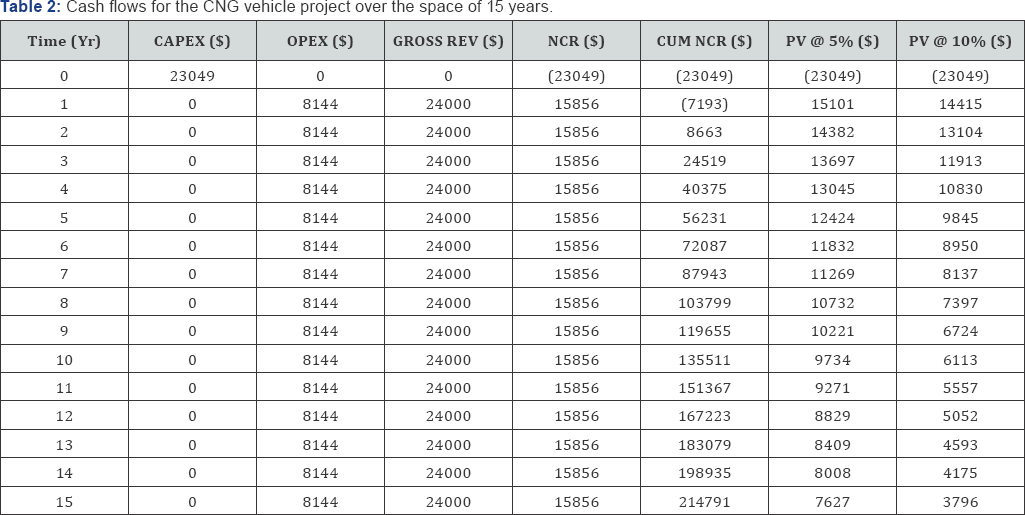

From Table 3 the Net Present Value at an expected rate of return/discount rate (the rate which the capital needed for the project could return if invested in an alternative venture) of 5% is the sum of the present values in that column for 5%. The sum of the PVs at 5% is $141531=N22.79 million The NPV at a discount rate of 10%=$97553=N15.71 million The project is worth investing on since the NPV in both cases is greater than zero.

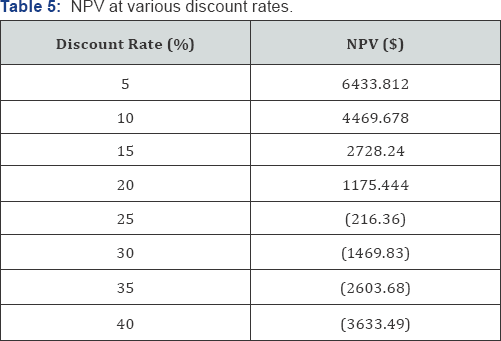
The internal rate of return (IRR) on investment of a project is the rate of return that makes the net present value of all cash flows from a particular investment equal to zero. The higher the IRR of a project, the more desirable it is to undertake the project. Table 4 is another table generated from Table 5 and it shows the cash flows for the project over 2 years. The essence of Table 6 is for the generation of the IRR of the project which has to be computed using very short times of undertaking the project. For more accurate values and for taking extreme cases, few numbers of years, like 2 to 4 years, is applied in generating the IRR rather than much number of years (Table 7). A table of the net present values for the CNG-powered vehicle project at various discount rates, which was used in generating a plot of NPV against discount rate as shown in (Figure 1) for the determination of the IRR which is 24%. The 24% is the discount rate at which the NPV equals zero.
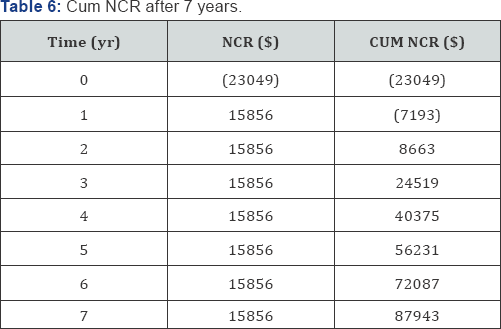
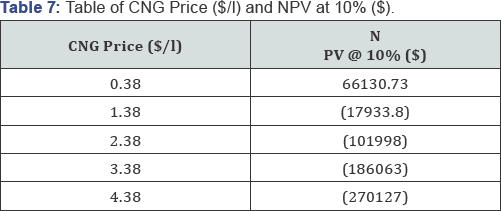
Pay-out (PO) for the CNG-powered vehicle project
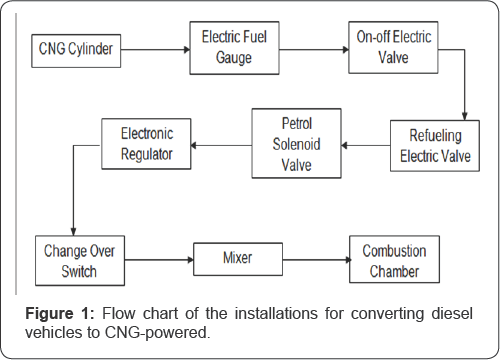
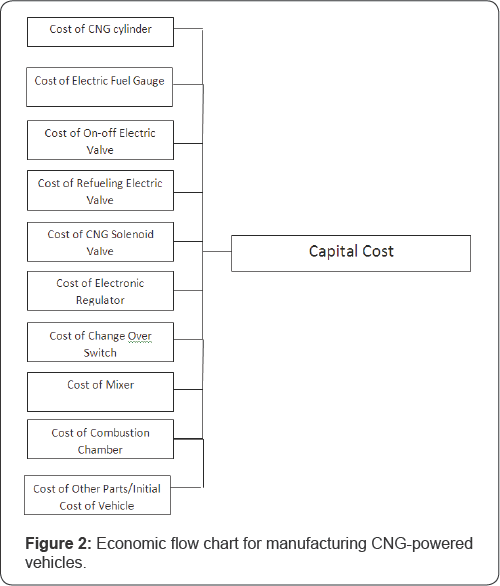
The pay-out for a project refers to the time (years) at which the initial investment on the project is just recovered. It is the time at which cumulative NCR becomes zero. Table 6 shows the cumulative NCR and NCR after 7 years while (Figure 2) represents the graph of time against cumulative NCR in billions of dollars for the CNG-powered vehicle project. From (Figure 2) cumulative NCR becomes zero between the 1st and 2nd year. In this research work, 1st and 2nd years were used as the initial point (IP) and final point, (FP) respectively.
Applying Interpolation
(PO-IP) / (FP - IP) = (0 - CUM NCR at IP) / (CUM NCR at FP -CUM NCR at IP) 3.2
(PO-1yr) / (2yrs-1yr) = (0 - (-7193)) / (8663 - (-7193))
PO = 1.45yrs as indicated in (Figure 3).

Effect of CNG Price on the CNG-Powered Vehicle Project

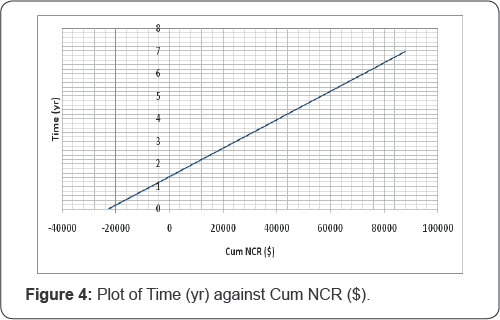
The NPV after 4 years at various CNG prices are as shown in Table 8 which was used to plot a chart of NPV ($) against CNG Price ($/l) as shown in. From Figure 4 if CNG price goes higher than $1.18 per liter ie N190 per liter, then the NPV becomes negative and so it would not be advisable to invest in the CNG- powered vehicle project.
Conclusion

Three profit indicators: NPV, IRR and Pay out were employed in this work for the economic analyses. The NPV that was obtained for the CNG analysis at different discount rate of 5% and 10% were both positive indicating that the project is profitable and acceptable. The IRR which is the rate of return that makes the NPV of a cash flow equals zero, tells us how efficient a project is. The IRR obtained from the CNG analysis is very much considerable. The pay- out period obtained from the CNG analysis is a very short period which makes the investment look very attractive and profitable. From Figure 5 it is shown that if the CNG price goes above N190/liter, then the NPV becomes negative and so it would not be advisable to invest in the CNG project at the end of the analyses, it is proven that it is economically viable to utilize CNG as vehicular fuel in Nigeria.
References
- West linn OR (1644) Go natural gas, inc what is CNG 1644 n. El camino real san clemente, Canada.
- (2013) Compressed natural gas (CNG) as a transportation fuel. Consumer energy center California energy commission, USA.
- (2013) Compressed natural gas. Wikimedia foundation inc, USA.
- Mumtaz A (2011) Pakistan has highest number of CNG vehicles: survey. International the news, USA.
- (2010) Natural gas vehicle statistics: NGV count-ranked numerically as at December 2009. International association for natural gas vehicles.
- (2011) Market studies series, consulate of the Argentinian republic GNC in Spanish. Consulate of the Argentinian republic Mumbai, India.
- (2013) Gases-heating values; resources, tools and basic information for engineering and design of technical applications. The engineering tool box.
- AGA monograph on underground gas storage. American gas association, Arlington, VA, USA.
- (2013) Compressed natural gas FAQ E vision technologies. Mahanagar gas limited, India.
- (2013) 800 Series valve specification. Nelson irrigation corporation, USA, pp. 1-6.
- Watt G (2000) Natural gas vehicles transit bus fleets: the current international experience. International Association for Natural Gas Vehicles (Inc.), pp. 1-92.
- (2013) Net present value. Wikimedia foundation Inc, USA.






























